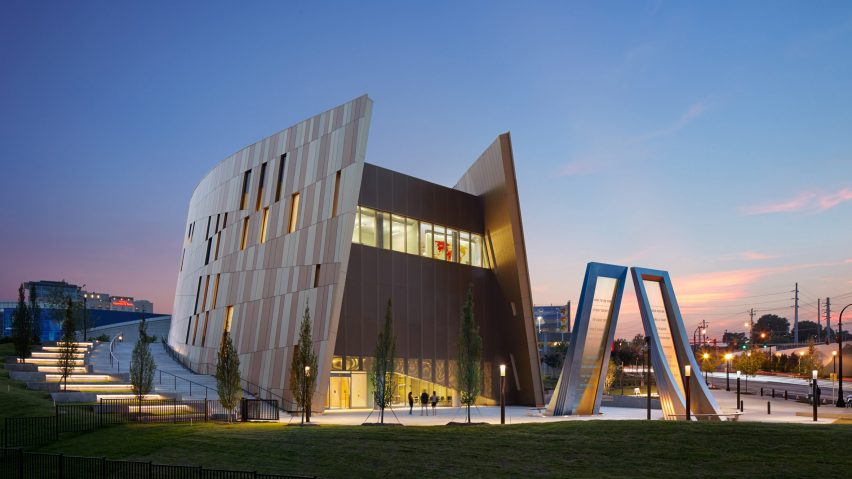African American architect Philip Freelon passed away yesterday following a career dedicated to projects that celebrate black culture in the US. We've rounded up seven highlights.
Smithsonian National Museum of African American History and Culture, Washington, DC
Completed in September 2016, the National Museum of African American History and Culture was designed as a collaborative project by Freelon's firm The Freelon Group, Adjaye Associates, Davis Brody Bond and SmithGroup.
Clad in perforated bronze, the building comprises three tiers that angle outwards towards the top. A feature of the museum is a circular waterfall in a dark room with a skylight above, intended as a symbolic gesture and as a space for reflection.
More than half of the museum is located below-grade, where visitors are meant to begin their tour. The levels dedicated to exhibits and artefacts covering slavery and freedom are situated underground. Upper floors contain exhibits related to pop culture, music, sports and art up to the present day.
National Center for Civil and Human Rights, Atlanta, Georgia
Built in Atlanta in 2014, the National Center for Civil and Human Rights is covered in multi-coloured panels designed to represent skin tones. Two slanted walls are divided by a glass curtain wall, which is an evocation of two hands coming together.
The Freelon Group designed the structure with firm HOK to be a centre that honours the past, present and future of the global human rights movement, as well as a space dedicated to the achievements of the American civil rights movement.
The museum is built on a grassy urban plot in Atlanta that was donated by Coca-Cola, a company founded there in 1886 by pharmacist, and slaveowner, Dr John Stith Pemberton.
Mississippi Civil Rights Museum, Jackson, Mississippi
Completed in February 2017, the Mississippi Civil Rights Museum is an expansive concrete and glass structure in the US state's capital city. Freelon completed it after his firm was acquired by Perkins + Will, and worked with local architect Jeffrey Barnes of Dale Partners Architects.
The building exhibits the history of the American Civil Rights Movement, between 1945 and 1970. It comprises eight galleries in a circular layout, surrounding a central rotunda. The structure shares a sun-lit entrance and lobby with the Museum of Mississippi History.
Jackson is rich with civil rights history and experienced mass demonstrations, as well as racial violence and extreme segregation. The new building is intended to honour the city's challenging past.
Emancipation Park, Houston, Texas
Emancipation Park is located at 3018 Emancipation Avenue in Houston's Third Ward area, which is historically a black neighbourhood. The site was at times the only public park available to African Americans during the Jim Crow era, which enforced racial segregation on a state-by-state basis from the late 19th-century up until the 1950s.
Freelon built a new structure for the park under his role at Perkins + Will, clad in differently coloured red and orange panels and topped by a slatted cantilevering roof. Rounding out the project are pavilions and renovated facilities, including a playground, a swimming pool and a performance hall.
Reginald F Lewis Museum of Maryland African American History & Culture, Baltimore, Maryland
The black Reginald F Lewis Museum in Baltimore features pops of yellow and red that are are reflective of Maryland's state flag.
The museum was completed in June 2005 by Freelon and his firm, and was designed to commemorate Maryland's African American history. The US state was part of the south before the American Civil War, located underneath the Mason-Dixon line.
An affiliate of the Smithsonian, the museum contains an original, autographed photograph of African American abolitionist, and former slave, Frederick Douglass and a first-edition of his famed autobiography.
Museum of the African Diaspora, San Francisco, California
San Francisco's Museum of the African Diaspora is located on San Francisco's Mission Street, inside St Regis Tower built in 2005 by Skidmore, Owings and Merrill.
The three-level museum comprises a variety of exhibits that documents the history, art, and culture of African migration around the world. A notable feature is the slave narratives it contains, complete with an introduction told by African American poet and novelist Maya Angelou.
Being part of the 42-story skyscraper, the museum is joined by condominiums and a 5-star hotel.
Motown Museum, Detroit, Michigan
In February 2019, Perkins + Will released images of its designs to overhaul the existing Motown Museum in Detroit, Michigan, with a plan created by Fenlon.
The project features a new multi-storey building with a glass curtain wall on its lower levels and a top portion wrapped in colourful strips, inspired by the spines of LP records. It is to join existing house-like structures that currently accommodate the museum.
Detroit is the home of Mowtown music, and the major expansion will create 50,000 square feet (4,645 square metres) of exhibition space for showcasing its legacy.

